Guide for Magic: The Gathering players
Some MTG players, especially those who favor the commander format, make the switch to VTES. They broadly consider VTES to be a perfected version of what commander attempts to be: a fun multiplayer experience, laced with a lot of interactions and negociations between them. Considering both games have the same creator (Richard C. Garfield), there are also a lot of similarities: that makes VTES an easy candidate for MTG players. But there are also a number of differences and these end up leading to unexpect misconceptions that are hard to overcome for us MTG players.

Life is mana
First thing, in VTES your life (pool) is also what you use to summon (influence) your vampires. So, in a sense everyone plays black. But, more simply put, even if you don't have to bother with lands, you have to have a real strategy about the beads economy here: how much will you invest in vampires and how much to keep for safety? It's obiously always better to invest more (more vampires, more actions, more power) but ideally you want to be just shy of getting ousted by your predator.
A large part of the game strategy actually revolves around that. If you're able to figure out how much you can be hurt by the rest of the table, you know how much you must keep in defense. And symmetrically, if your predator can somehow mess with your assessment and push you to underestimate them, they will have an easy grab for a Victory Point. This is what VTES players refer to as the lunge. Estimating precisely how much your predator can lunge for (the number of pool damage they can deliver) is key, as is obscuring this information on the predator's end.
Cards replacement
This is really the main difference: in MTG you get one new card per turn. Card management is a thing: card advantage is a core strategical concept. In VTES, you replace every card you play. There's not card advantage in the sense MTG players know of. So, what does that change?
Play your cards
Well, the first thing you will have to relearn is to play and discard your cards. As an MTG player, you will have an unreasonable tendency to stick to your cards and not want to play them until the perfect moment. You need to unlearn that. In VTES, playing a card costs nothing. If the effect it has even slightly advantages you, that's a net gain. You need to play all the cards you can all the time. At the end of a game, the more cards you played, the more chances you have to win: more cards played means more effects, which means more advantages, and that should put you in a dominant position.
Discard every turn
It's the same thing with dicarding at the end of a turn: not an easy thing at first but in fact, you need to discard often because, again, it costs nothing. If discarding a card has more chances to improve your hand that it has chances making it worse, you should discard. And 80% of the time, given you choose what you discard, the chance for improvement is big enough that you should.
Keep the right cards
The other side of the medal is trickier. Once you've learn to play all the cards all the time and discard at every chance, you will need to relearn when not to do it. It largely depends on the deck and how it's built but some cards are supposed to be used liberally, others are supposed to be kept or discarded depending on the table situation. When not to discard is almost as tricky. You need to know your deck and assess the table well enough to notice when your chances for hand improvement are poor: you have a very decent hand and discarding anything in it might do more harm than good. This happens maybe 20% of the time.
Example
Say you're playing the 25th Anniversary, you got Ingrid and Stanislava in crypt, and after a lucky Zillah's Valley you play immediately, you draw a Govern the Unaligned and get this hand at then end of the turn.
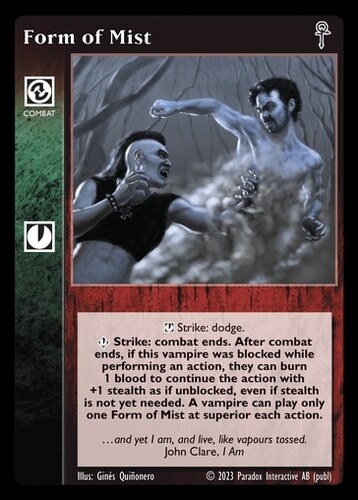
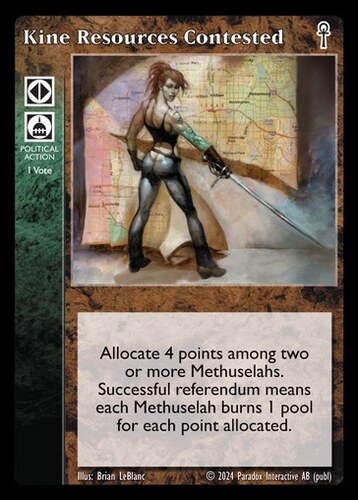
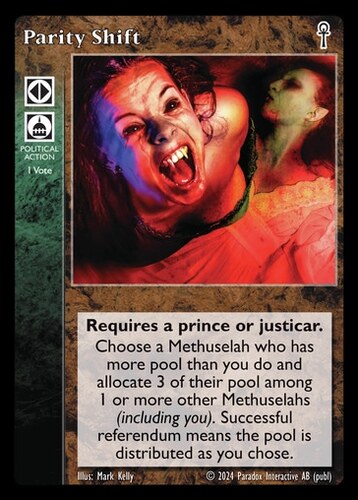
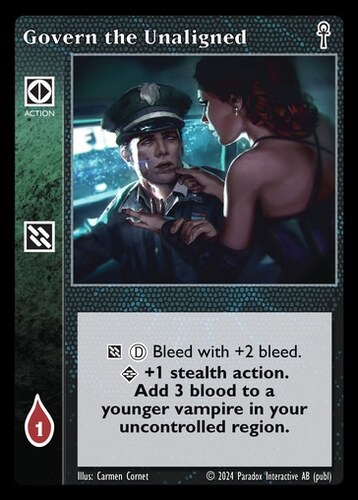
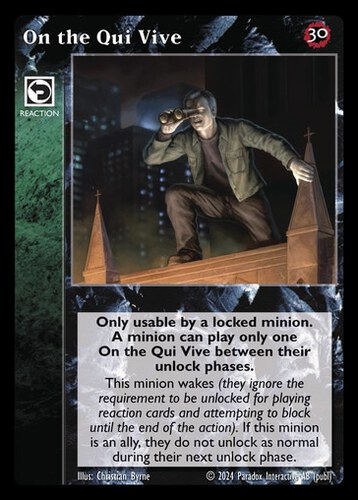
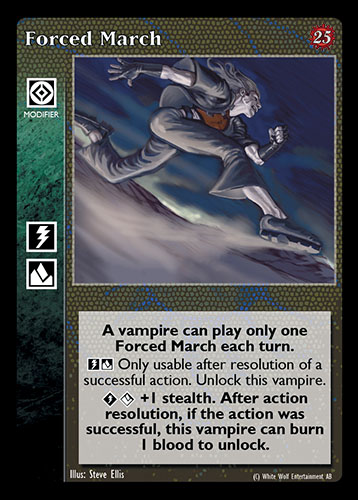

First, it's a good hand: you got a Govern and the stealth to make it through, and even a Forced March to unlock and follow up with another action. Once Stanislava gets out, her first turn should go well. Now, what to discard? It is not a perfect hand and, even with the early Zillah, you got two discards until Stanislava acts. Not discarding here would be a mistake, because there are many possible improvement: any master would be a card to play next turn, where you still have no vampire. If you get Information Highway, another Zillah, or a Dreams, it's a treat. More importantly, you need a Villein early, and you don't have it yet, so you should cycle.
So, what to discard? The second Govern is a keeper: being able to play two Govern at superior in the first two turns is ideal. The stealth should be kept to secure those actions, and Form of Mist can also be used to end a dangerous combat if someone rushes you just after you get out. So it has to be Parity Shift, Kine Resources or On the Qui Vive. Stanislava won't be able to play Parity Shift so you might think that's the one, but that would likely be a mistake: it will not be used immediately, but once Ingrid gets out, she should go for it immediately to get some pool back, especially if you did not draw a Villein by then. On the Qui Vive then? It is too precious: the deck does not run a lot of wakes and later on and combined with a Deflection, it will save you pool and maybe even cost some to your prey.
The conclusion is inevitable: Kine Resources has to go. Stanislava can bleed as a second action, or just play it slow and keep Forced March for later, there's no urgency this early in the game to deliver a 3 damage vote to your prey.
Card pool and cards limit
VTES is a smaller card pool than MTG. It holds 3900 cards and, sure, MTG standard (∼1500) has less, but it is renewed every year. Modern holds four time this amount (16K), not mentioning the popular Commander format (24K). But there is no expansion block in VTES, and no limit in the number of copies of a card you can put in a deck. This is a dramatic difference. It means some very powerful cards in the game can (and are) simply used in 10 or even 20 copies in some decks.
So you don't have a lot of similar cards with very close effects to just combine together for stability and, since there are no block nor cards limit, design teams learned that just editing "very close" cards in the end means that one is better than the other and makes it obsolete. When designing similar effects on cards, they need to figure out just enough of a difference to make both cards relevant in different situations.

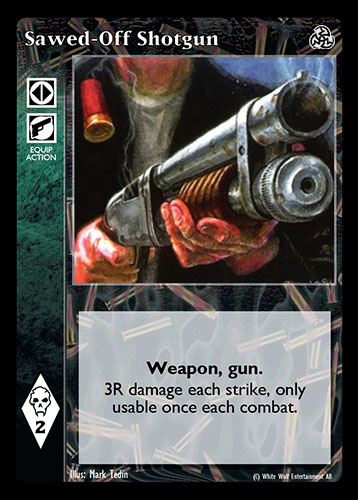
Chainsaw was never reprinted because Sawed-Off Shotgun is just a straight-off stronger version of it. Gas‑Powered Chainsaw was printed instead later on.
At first, you'll need to learn about more cards that you would need to discover when drafting or playing Standard. But once you're there, these don't change much expansion after expansion. Any new good card can change the metagame and the decks dramatically, since you can include it in any number of copies. That's an interesting journey once you're past the initial discovery phase.
Luckily though, you don't need to get to know all 4000 VTES cards. You can check the Best Cards section to learn about the 500-600 most played cards in the game. Roughly knowing this third-of-a-block of Standard will cover 80% of the cards you're likely to see on any given table.
60 or 90 cards deck?
The lack of cards limit also makes thinning out a deck a different question. Because of the limit of 4 cards in MTG, the smaller your deck, the more stable your draw: you should make your deck as small as possible. In VTES, since there is no card limit, you can have the same stability in a 60 or a 90 cards deck. If you play 10 Govern the Unaligned in a 60 cards deck, playing 15 in a 90 cards deck gives you the same draw chance (with a tad more variance, yes, for you statisticians out there, but you get my point).
So yes, 90 cards decks are a thing. As are 60 cards and anything in between. The size of a deck has more to do with the expected card flow intensity than anything else. Check the Deck Building section if you want to dive a bit deeper in this topic.
Your prey is on the left
You will hear this saying a lot in your first few games. And it's not the most natural thing when you come from MTG at first. All players on the table are your opponents and, in the end, only one will win, but your prey is on your left. And sure, it's obvious: 6 pool is always good to take and Victory Points are how you win. So of course ousting your prey is always good. Anything that hurts your prey is a good thing. Remembering it is vital: you're not there to be just or equalize the chances around the table, you're here to oust your prey.

Defending is important too, of course, but because life is mana, the more the game goes, the less pool people have. There is a natural attrition mechanism at play here: minions cost pool, their cards cost blood, combat costs blood, and, ultimately, blood is pool. Surviving is important, but surviving while ousting your preys and getting pool for it is how you win.
The lunge
The lunge is the first tactic one needs to learn as an MTG player. Some MTG tactics have to do with tempo, but in a very different way, since it's more about card tempo.
The lunge in VTES is all about "damage tempo". You want to keep your most damaging effects in hand for the exact right moment when they will bring your prey to zero. Consider you're playing a stealth bleed deck (one of the simplest archetype to go with): a beginner MTG player will often just deliver whatever they draw and go forward with it full power, trusting the deck to bring as much damage as fast as possible, while an experienced player will make sure the damage is progressively higher and the finishing move is overwhelming.
Example
No lunge: 6-2-4-3-3
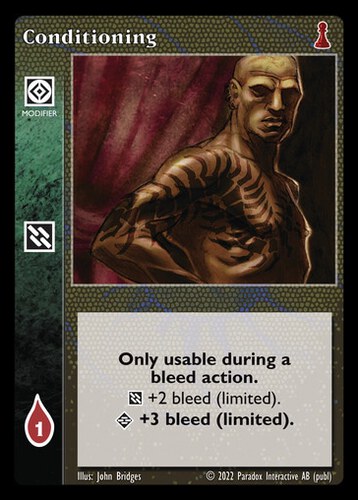






This first sequence is clumsy. It strikes very hard at first but then struggles to deliver damage later on. Keeping the initial Conditioning in hand would have been the right move here. If the two last actions are in a second turn, this sequence leaves the opponent at 6 pool after he just took 12 pool of damage.
Lunge: 3-2-3-4-6







This is a proper lunge. The last turn delivers superior damage suddenly. Again, if the two last actions are in a second turn, this sequence leaves the opponent at 10 after having delivered 8: it is harder to asses how fast the oust can happen. Note players got access to the same cards, they just played them in a different order.
This is an essential tactic in the game: if you deliver too much damage too soon without ousting your prey, you're making the game harder for you: your prey will invest less pool and will take a more defensive stance, but also the rest of the table will mark you as more of a risk and hinder your efforts.
More importantly, putting your prey low in pool while failing to oust them is really a signal for your predator than it's time for them to lunge. In a position like that, if they manage to oust you, then you've served them their second victory point on a silver platter. So failing to lunge will not only push your prey to go very defensive, it will also offer such a golden opportunity to your predator that they will have to be as offensive as possible to try to profit from it. It's a dreadful situation to put yourself in.
Lunging is difficult. The fact that life is mana makes the whole game that much tenser. You need to learn to pilot your deck so that it not only delivers the damage it needs to deliver but does it, as much as possible, in an overwhelming and categorical fashion. Keeping your prey on low pool without managing to oust them is a losing proposition.
Cards in 1 copy
Another difference is that in MTG you usually get to play 20% to 40% of your deck. The deck size lower limit is far higher than the number of cards you get to play. Not so in VTES: if you do not get ousted early, it's customary to play 60% to 80% of your deck, and deck sizes should be tailored with this objective in mind. If you tend to play a lot of cards, you'll go with an 80 or even a 90 cards deck. If the flow is slower, you should opt for 60 or 70 cards.
You will often see decks fielding cards in a single copy, which for MTG is basically an heresy, since you are more likely to never draw a single-copy card in any given game. In VTES, with a well-built deck, you are likely to draw any single-copy card you put there in 2/3 of your games. So 1 copy is a good number for a silver bullet, although that means you need to keep it if it's relevant and discard it if it's not.
Duplicates in disguise
Some single-copy inclusions are actually multiple copies in disguise: the different cards all serve the same purpose. A good exemple is permanent intercept devices. You will see decklists with Bowl of Convergence, Aranthebes, Mr. Winthrop, and KRCG, all in a single copy. If one is better than the others, why not just play 2 or more copies of that one? Well, since you're drawing the majority of your deck in a game, it is better to get different unique cards you can stack than it is to get the best one sooner. All in all, it matters more to be able to stack effects and get a better setup than having an early impact. It is linked to the lunge tactic: the buildup is useful because stacking and damage tempo matter, the card tempo matters less.
Not to say that in some cases you shouldn't field multiple copies of a single card. In some instances there is no good alternative or you really want your draw chances in any game to be closer to 90% than to 70%. You will see for example Ravnos x decks fielding two Week of Nightmares, combat decks with 2 or 3 Fame, or demanding toolboxes or combo decks with 3 or 4 Heart of Nizchetus. It is possible and sometimes relevant, but most of the time spreading multiple different unique cards in a single copy is better.
Vampires are not creatures
It's tempting to think of vampires as if they were creatures in MTG, but it is misleading. Because life is mana, vampires are more costly than most MTG creatures. They're also more resilient: you can probably send a vampire to torpor with a good combat module, but destroying a vampire takes a lot more dedication. But beyond those obvious differences, the rift between VTES vampires and MTG creatures goes deeper.
The two strength scores
In VTES, a vampire delivers strength damage to other minions, but bleed damage to the opponents pool. This changes things. The way the game is designed, some vampires can deliver high bleed damage, others are excellent combatants and can deliver high damage to minions. But the two rarely go hand-in-hand. An vampire is a dangerous bleeder, but weak in combat, and a vampire won't bleed much, but will be a dreadful combatant.
And it's not just about strength. A high capacity vampire does not really have "more life", nor is it more robust. A vampire's capacity does not matter if their opponent use aggravated damage like Claws of the Dead or just a Disarm. And, even if a high capacity vampire can take a big Roundhouse more easily, they do not regenerate between turns, so it's just a one-time thing. High capacity vampires bring more disciplines, titles and interesting special abilities. Their capacity is not toughness: ideally their blood should be recouped with a Villein to go back to the pool before they lose it.
Vampires are lands
We started this article stating that "life is mana", but if you think about it, and even though you pay in pool for your minions and some other cards, 80% of the library cards are actually played by your minions. So in a very practical way, vampires are lands more than anything else: without them, most of your cards are dead cards and you stop playing. What you can play depends on their disciplines and the disciplines are the colors of a deck.
Combat is control
Because good combat vampires are often poor bleeders, but mostly because vampires are lands, combat decks are not "aggro": they are control decks. Putting vampires in torpor slows down your opponents, destroying them is more akin to playing a good Armageddon: it can be devastating, but you have to time and aim it well.
By destroying the vampires of your opponents, you slow or even shut them down. Inevitably, this will also advantage the remaining players: it's disrupting the table balance. Ultimately, you have to do so in a way that advantages you more than the remaining players so that you end up winning the game.
And it's not easy, because with combat-oriented vampires and cards, you will have poor options to take down your prey's pool after you dealt with their vampires. Your vampire-killer star might still bleed for only one or two, and you need to oust before your predator gets you and nets the 2 victory points you're serving him on a platter.
Delicate planning and foresight are required to win this way. Despite the cards color, decks focused on combat are not aggro Red decks. They're Blue, maybe Dimir. Their game plan is to win the table in the long run by locking everyone out of their game: they do not aim for a quick victory.
Archetypes parallels
It's a bit tricky to make a parallel between MTG deck categories and VTES ones, but let's give it a try so you can get to know the lay of the land here.
Aggro ➔ S&B
Stealth & Bleed decks (S&B in short) are to VTES what the aggro decks are to MTG. Fast heavy damage to your prey, skewed towards the offensive side to try and secure the victory quickly. The V5 Malkavian preconstructed deck is an example.
All types of very forward bleed decks can be thought of as aggro, not only the stealth ones. Powerbleed decks like Rebekka/Jost also fit the bill here. Some very aggressive swarm decks like Legacy of Pander and Weenie DOM, also qualify.
Control ➔ Rush & Wall
There are two kinds of control deck in VTES. Rush decks are active control decks, where you go rush opponents minions to control the table (im)balance and skew it in a favorable way. Tupdogs & Nephandus is a good example.
Wall decks are reactive control decks, where you use reactions to stop your opponents actions and hurt their minions, like in the V5 Gangrel preconstructed deck.
Whatever the approach and similarily to MTG, actually winning with these decks requires a good grasp of the existing archetypes so you can assess your opponents' strengths and weaknesses.
Midrange ➔ toolboxes, vote & bleed
Toolboxes evidently match the "midrange" idea: they bleed, they block, they do a bit of combat, sometimes they even vote. There are a lot of differently-themed toolboxes. The decks of the V5 Box, except the Malkavian q, are midrange decks in that sense, although they have different approaches.
Vote & bleed decks, often relying on Inner Circle vampires, are definitely midrange. The 25th Anniversary Stanislava deck is a good example. Some slow bleed deck do not include votes: The Bleeding Vignes is also midrange: good defense, steady aggression.
Combo ➔ swarm, combo
Many swarm decks actually fit what an MTG player would expect from a "combo" deck. They have a build up phase with low table impact, and an overwhelming endgame that can sweep the whole table. They also rely on a 2 or 3 cards combo and good synergies: the Ravnos Clown Car, Palla Grande or Khazar's Diary are good examples.
Then, there are the more intricated combos decks that are also qualified as such by VTES players. They are different from MTG combo decks: because there is no cards limit, it is possible to make some very long multi-cards combo work often enough to build decent decks out of them. Check out Baltimore Purge or Cybelotron, for example.
This is a multiplayer game
Well, we haven't even talked about the biggest difference yet: while MTG is a duel game, VTES is a multiplayer game. It is designed and balanced to be played on a table of 4 or 5 players. This has a few important consequences, which should be familiar to Commander players.
Table assessment
To be able to take any strategic decision, you will need to refine your ability to assess a table. Table assessment is the art of figuring out quickly who is playing what kind of deck, grasp the kind of resources they are likely to have, and deduce what their strengths and weaknesses are most likely to be. The opponents will whine and lie and try to manipulate you during the game: it's a big part of the game.
If you're able to maintain your own perception of what's going on, who's struggling and who's dangerous, you will be able to control the game and have it progress as you intend, rather than be just a tool for another Methuselah to use. You need to know the different archetypes and, ideally, play them to get a feel for them. Experience is what will make you able to refine your table perception.
Table fold
The way a table folds is who gets ousted in which order: like an origami, tables get smaller and smaller with each oust. When you get better at table assessment, you'll be able to predict and influence how a table folds.
Coming from MTG, a very fast-paced game where tempo is key, it's easy to fall in the trap of trying to go very hard and very fast on the left, on the prey. It can absolutely work, but there's a lot more to VTES than this and, on average, going too hard too fast on your prey is a losing proposition. Against experienced players, you'll leave so much breathing room to your future preys that they're actually more likely to win the game than you are.
Getting good at predicting how a table folds is crucial: you want your strategy to take into account the way the game is likely to progress. This perception is key to how the game is played. At high level, the fold is a cornerstone of strategy, so much so that players will purposedly influence the fold itself to push the opponents to change their strategy.
Table talk
Finally, yes, VTES is a game of negotiation and manipulation. You need to talk, to influence others' perception, to be inventive with the deals you propose to your opponents, all the while maintaining a pleasing and discreet demeanor so as to avoid unecessary aggressions against you and even encourage the odd gift of a slight advantage.
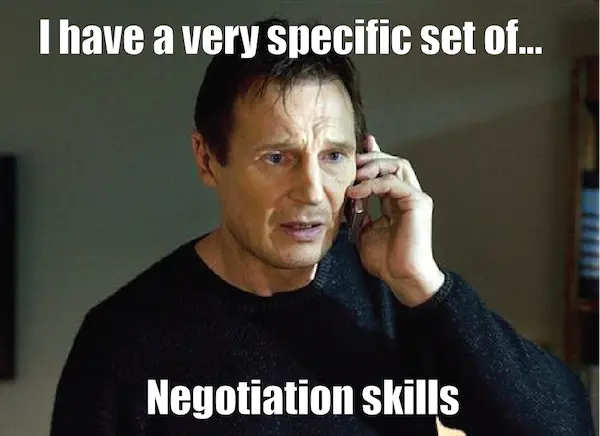
You can win silently but you'll get consistent in your wins only if you learn how to negotiate well. Check the table talk section for a thorough explanation of the tools at your disposal here.
The saying is: victory is 50% the deck and 50% the player. The best players can win tournaments with average decks. Hugh Angseesing, the current CEO of BCP and one of if not the best player in the world, managed to place all V5 preconstructed decks in tournament finals when they got out, just to demonstrate it was doable with no tinkering.
